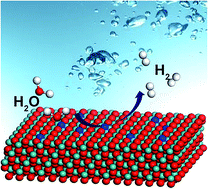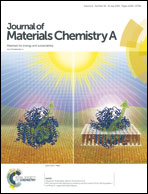Nitrogen-promoted molybdenum dioxide nanosheets for electrochemical hydrogen generation†
Abstract
Recently, the hydrogen evolution reaction (HER) via electrocatalytic water splitting has provided a promising and sustainable strategy for energy conversion and storage. A cheap and efficient electrocatalyst composed of earth-abundant elements is needed. Here, we have synthesized new samples of N–MoO2 sheets with excellent stable Pt-like HER performance. A simple and repeatable strategy has been developed via the use of the cheap, simple small organic molecule urea as a reducing agent. We confirm that N doping can induce a disordered surface lattice and increase the number of proton adsorption sites with a relatively weak binding force. Owing to the cooperative effects of surface N doping, disordered surface distortion and the intrinsic nature of MoO2, high HER activity can be achieved, with an overpotential of η = 96 mV vs. RHE at a current density of −10 mA cm−2 and a Tafel slope of 33 mV per decade. Moreover, we further extended the synthesis method to Ni and Co systems with the formation of N–NiO/Ni and N–CoO/Co core–shell structures, which exhibited enhanced HER performance in comparison with bare MO/M (M = metal) samples. This study can help us design new earth-abundant electrocatalysts with further enhancements in catalytic performance.



 Please wait while we load your content...
Please wait while we load your content...
